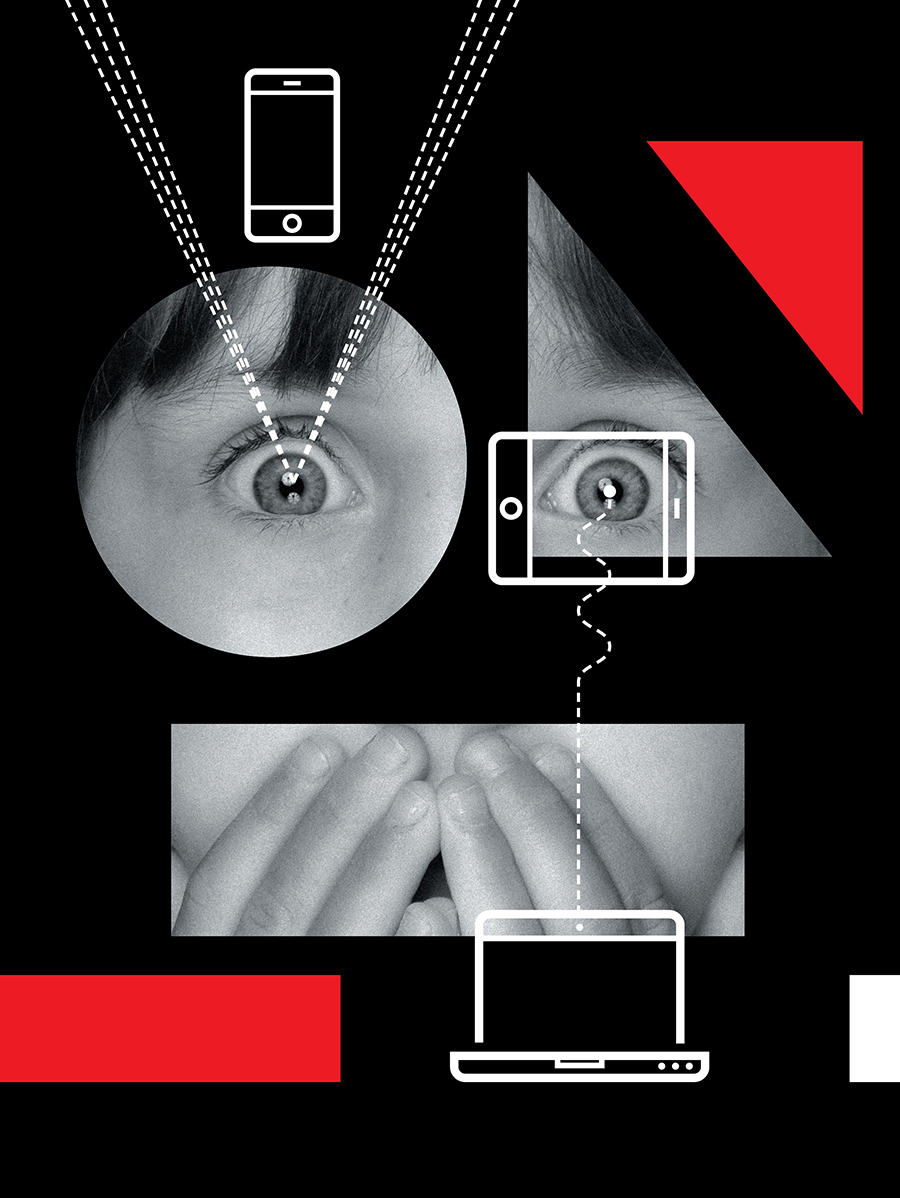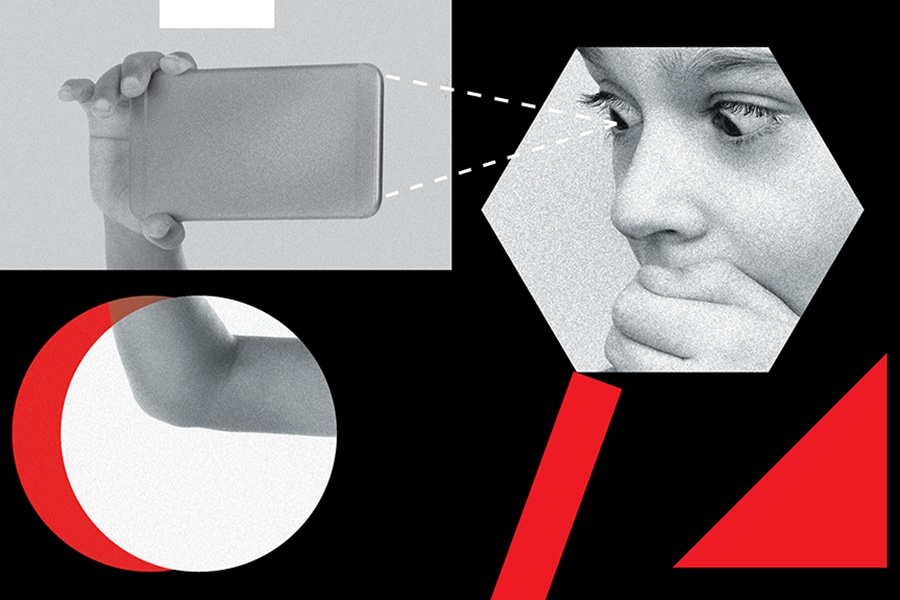The Birds and the Bees… and Porn
The good news is your kid is not having sex. The bad news? That same kid is probably watching online porn or sending naked pics. But does this mean our children will be sexually screwed up forever?

Thinkstock
This isn’t an easy story for me to share. Nearly three years ago, my happy-go-lucky nine-year-old kept disappearing to his room for long stretches of time. I’d call to him repeatedly until he’d finally join us with uncharacteristic reluctance. When I’d smooth his stubborn cowlick and ask, “Is everything okay?” he’d mumble “yes” and pull away. I didn’t believe him, but I didn’t know what I was looking for.
Then one evening, after the kids had gone to bed, my husband noticed that his old iPad with the cracked screen was missing from his desk drawer. Tiptoeing upstairs, he found it under one of my boys’ beds. On a whim, he pulled up the browser history, confident he’d find links to forbidden online games. Instead, he found the raunchiest pornography I’d ever seen—the kind no adult should ever see, let alone a child. And my sweet fourth grader, who still fell asleep with his favorite stuffed dog clutched under his arm, had just watched hours—no, days—worth of it.
When we woke him up at dawn the next morning (after our sleepless night), he burst into tears at the sight of the iPad. My husband held his composure as he told my son that what he’d seen was not how two people who love each other act—that that behavior isn’t real and it’s not what sex is about. Then he asked my son if he had any questions. He shook his head, refusing to meet our eyes. We gave him a hug, and said it was okay and that he was going to be fine. Still sobbing as he stood to get ready for school, he turned to me and said, “I’m sorry, Mom, I didn’t mean to. I just heard them talking about a website on the radio, so I looked it up and then…. ” His face crumpled.
I knew exactly what the “and then” was—and it still haunts me.
I didn’t tell anyone about the incident for a long time. I was mortified. How could this have happened to us? My husband’s a techie who prides himself on locking down all of our electronic devices (except, of course, the forgotten iPad). I had steadfastly refused to get my three kids smartphones, tablets, or even iTouches. We’d done all the right things—or so we thought.
Turns out, our story isn’t unique. When I put out a Facebook request for stories like mine, a mother of three wrote, “Everyone with middle-school-age children that read [your post] and said to themselves, ‘Phew, I’m glad I’m not there,” just hasn’t found it yet. But their kids have.” Some studies report that as many as half of seven- to 18-year-olds have been exposed to sexually explicit websites (others say that figure is closer to 80 percent). That’s an astounding number. And just to be clear: It’s not the same as finding your dad’s Playboy magazines in the back of his closet. These are second graders searching for Disney’s Moana, for example, and being flooded with images of bondage, group sex, and bestiality. It’s all just a click away.
So when the news media recently heralded the results of a Centers for Disease Control and Prevention survey showing a very significant drop in teenage sexual activity between 2005 and 2015, I didn’t exactly jump for joy. Sure, it’s great that kids are waiting longer to have sex, that they’re using birth control, that the pregnancy rate is at a record low. But make no mistake: Kids aren’t just sitting around together in the basement playing gin rummy. With the entire world wide web at their fingertips, they’re accidentally stumbling onto hardcore porn before they’ve even learned about the birds and the bees; or they’re searching words like “boobs” and “blow job” and getting a whole lot more than they bargained for; or they’re Snapchatting photos of their genitals to impress their classmates. Never before have kids had this ease of access to X-rated content at such a young age.
While we’re all glad they’re not 16 and pregnant, I have to wonder: Is this hypersexualized online culture messing up our kids? And what are we doing about it?
First, the hard truth: your kid is going to see porn—no matter how good of a parent you are, or what you do to prevent it. Because if it’s not on the family laptop, it’s on some other kid’s device at school or on the bus. Because all your son or daughter has to do is mistype one letter of a domain name and unbidden images suddenly appear. Because dozens of children’s characters (such as Pokémon and My Little Pony) are linked to thousands of porn sites. Because even Pinterest has pornographic content. It’s pervasive. Cordelia Anderson, an educator who’s worked extensively in the field of child exploitation, goes as far as to say that “the porn industry is the country’s main sex educator of our boys and girls.” If that seems extreme, consider that teens are the largest consumer group of porn.
Just what are they seeing? The answer is some pretty raw stuff. A former elementary school teacher and mother of three who caught her nine-year-old viewing porn on his iTouch says she was shocked by how graphic the videos were: “It was this crazy, violent, hardcore porn—the kind with no narrative.” We’re talking about explicit sexual activity: close-ups of genitals, visible penetration, and copious anal sex—way worse than the cheesy “bom chicka wah wah” of our day. I had to leave the room when my husband pulled up the videos my son was viewing on our iPad: three-on-one sex; men slapping and ejaculating on women’s faces. There was nothing mutually pleasurable (nor seemingly consensual) about the humiliation and degradation I saw—and it was as far removed from lovemaking as you can get.
But that’s become the norm. Porn today is so much nastier than it ever was before. Even the vanilla, front-page stuff is pretty much predicated on violence, submission, and misogyny. Venture down that rabbit hole a little deeper, and you find a Willy Wonka–like world with every fetish imaginable (even orange-faced Oompa Loompa sex). Porn is so expansive that it’s basically a catalog of all sexual desires—“The Kinsey Report of Our Time,” as an article in New York magazine last year called Pornhub, the Internet’s largest porn site. Or, as the Internet truism known as “Rule 34” puts it, “If it exists, there is porn of it—no exceptions.” There’s no going back, and when parents are in the surreal position of having to give their kids the “porn talk” before they’ve even had the “sex talk,” there’s something very wrong.
Worried by my son’s porn binge, I made the rookie error of Googling “kids and porn.” As far as the Internet is concerned, my boy’s sex life will be forever warped. One site said that porn is highly addictive and “works in the male brain similar to the way cocaine does,” making the user need and want more. Once someone becomes addicted, he is “trapped in a never-ending cycle.”
Another site told me that males who compulsively watch and masturbate to porn may experience delayed ejaculation, requiring more and more stimulation to climax. And when they’re with actual human partners, they may have trouble getting erections because they’re so used to the perfect women they see online who are willing (and paid) to basically do anything to get the job done. As I scrolled through page after page, my son’s prognosis only got worse.

Thinkstock
Even in the midst of a parental freakout, however, I know enough to not trust every hysterical hunch the Internet has to offer. So I bit my lip and decided to find out for myself by calling Steven Schlozman, associate director at the Clay Center for Young Healthy Minds at Mass General, who’s written about how to talk to children about Internet pornography. As I relate our story, he asks how old my son was when it happened.
“Nine,” I reply anxiously.
His response makes me feel better almost immediately: My son was merely curious, he tells me, as a lot of kids are—it’s a healthy part of human development. I let out a sigh of relief. What’s more troubling to Schlozman is that kids may think what they see online is normal sexual behavior. “If this is their standard—the most incredible sexual experience that anyone’s ever had—it’s not going to happen,” he says. “It takes work and practice.”
One of the problems is that porn is a bad how-to guide for actual sex. Lynn Margolies, a clinical psychologist in Newton who works with teens and their parents, tells me that “kids can get tricked into thinking the images they see are real—that it’s how they and their partner should look and act, and what they should do and feel.” If that’s their only view of what sex is, Margolies says, those expectations can lead to “a disconnected, contrived experience, instead of natural exploration and connection.” Or, to put a finer point on it, “Trying to emulate porn doesn’t feel good like in the videos and can negatively shape their first experiences of sexuality.”
Of course, that’s assuming our kids make it past first base. We know from the CDC’s survey that a good number of them are opting out of fumbling around in the backseats of their parents’ cars—perhaps for the cool, lonely glow of a screen.
There’s also the very real concern that this tidal wave of porn is creating a generation of young men (and, to a lesser extent, women) who struggle with intimacy—who prefer porn to real human interaction because it’s less complicated and comes with no strings attached. When you have access to hundreds of millions of pictures of vaginas at the click of a mouse, why bother with the real thing? In other words, maybe our kids aren’t waiting to have sex because they’re better informed about the risks, as health educators boast. Maybe they’re just not interested.
But what if that’s not it? What if kids are interested, but they’re just not sure what to do with a partner in real life? That’s a theory parents can actually wrap our heads around because we know what that feels like. We, too, had no idea what we were doing when we were their age (remember French-kissing Tiger Beat posters?). Then again, we didn’t have an impossible standard to live up to. We hadn’t already seen every position and technique in the book—in action. We simply closed our eyes and let our libidos take care of the rest. These boys, who’ve grown up learning about sex from pornography, ironically have no clue how to seduce a female. There’s no romantic intimacy in porn, no lighthearted foreplay; rarely is there kissing or laughter. No wonder they’re confused. The concept of sexual tension is completely lost on them.
In fact, porn offers just the opposite: Rough and violent sex is de rigueur. Spending countless hours browsing porn over the past few months for this article, I never once heard a man ask for consent. As far as I can surmise, “no” doesn’t really mean “no” in porn; it means “Throw me onto the bed and come at me from behind—and I’ll protest vaguely, but I really like it.” If that isn’t messing with our teenage boys’ minds, I don’t know what is. And it keeps getting more extreme and deviant as the adult film industry looks for new ways to lure consumers. I was horrified to learn that one of the fastest-growing categories is incest porn. Yep, you read that right: fathers with stepdaughters, moms with stepsons, stepsisters with stepbrothers.
Is this how we want our kids to learn about sex?
I don’t think so. But if we’re powerless to shield them from porn—if filtering and blocking software and monitoring screen time aren’t working—then we must give kids the tools they need to understand what they’re seeing and to recognize that it’s not real.
So where should that discussion take place? A mom of two, who caught her 11-year-old daughter watching porn on her phone, brought it to the dinner table. “I told my kids, ‘Porn is not real life. If you want to see a photo of an erect penis, I will show you one,’” she says. Her red-faced daughter declined. Yet not every parent is comfortable having that conversation. Does that mean, then, that we should incorporate it into the sex-ed curriculum at school?
In Wayland, where I live, kids learn about the reproductive system and their changing bodies from teachers starting in fifth grade. I still remember the day my 10-year-old boys came running off the bus with samples of Old Spice deodorant…and a rudimentary understanding of how babies are made. But here’s the irony: One of them had already watched people having sex by then (in myriad positions with multiple partners, no less).
How do you reconcile that?
Emily Rothman, an associate professor at Boston University’s School of Public Health, has an idea. Two years ago, Rothman, with public health educators Nicole Daley and Jess Alder of the Boston Public Health Commission, helped create a five-week pilot course—nicknamed “Porn Literacy”—for a select group of Boston high school students to teach them to think critically about sexually explicit media. The idea came out of Start Strong, a peer-leadership program funded by the BPHC and based in the South End that has a goal of preventing teen dating violence and abuse.
Though it wasn’t a requirement to have watched porn to participate, all the teens in the class had. They had lots of questions, as well as misconceptions based on what they’d seen online: that girls like to be dominated, for example, and that anal sex is commonplace. The instructors presented the facts in a straightforward, nonjudgmental way, encouraging the kids to challenge what they see—to understand that porn is entertainment, just like professional wrestling or any other show they watch on TV. When I ask Rothman whether some parents might interpret the class as promoting porn, she tells me, “Kids are going to find a way to watch porn no matter what we do.” Neither does she think it’s right to “blame technology” or effective to “nail down access to the Internet.” After all, she says, “It doesn’t solve the problem.”
That problem being: Kids have nowhere to learn about sex. “A lot of the conversation now in sex-ed classes is about birth control and pregnancy prevention,” says Daley, the Porn Literacy co-creator and a former director of Start Strong. “But kids are still walking away wondering: How does sex actually happen?” They learn about the biology, the changes in their bodies during puberty, and the importance of healthy relationships. But how does all that fit together? “They find [the answers] in porn,” Daley says. “It offers the visual imagery that satisfies that question.”
That was my “aha” moment. Children in this new digital generation are visual learners: They want to see everything in action. The problem is that what they’re seeing is more than just sexual fantasy—it’s often violent and disturbing, or, at least, not relevant to actually having sex. Hence the need to give kids a lens through which to view what they’re likely going to watch anyway. I ask Rothman and Daley if they could imagine the curriculum being taught in public schools. “I think we’re a long way off from that,” Daley says.
Rothman agrees. She can just imagine the headaches of approaching a superintendent and school board: “We don’t have time to argue it. There’s always going to be some parent with an issue.”
They’re right. When I float the idea to a mother of three teenagers, she says no way: “I want school to teach my kids to read and write. I’ll teach them the dangers of porn at home.” Still, she’s not happy with the current sex-ed curriculum. “I wish we were talking more about abstaining,” she says. “I know the argument is that they’re going to do it anyway. Well, they will if you give them everything they need. If you teach them how to put a condom on a cucumber in ninth grade, they’re going to do it.” The same goes for porn. “I think we need to be telling our kids absolutely no porn, no sexting,” she says.
Rachel Hanks, a wellness teacher at Wayland High School, sees it differently: “We’ve figured out that teaching abstinence doesn’t work, like ‘Just say no’ to drugs didn’t work.” She doesn’t think it’s wrong for teens to watch porn. “They’re curious,” she says. “It’s very normal.” She thinks by not addressing it, “We’re doing the kids a disservice. The minute you put shame on a subject, or indicate it’s not okay to talk about it, you’re saying they’re doing something wrong.”
Interestingly, Hanks thinks high school is too late to address the topic with kids. “I’m not saying they’re too old to talk about porn,” she tells me. “But they’ve already negotiated it by then.” She thinks middle school is the time to bring it up. Again, Hanks emphasizes, “Not to teach that it’s wrong, but to explore what messages they’re sending. And to let kids know when they should be concerned—if they’re watching it all the time.”
Porn Literacy teacher Daley hopes that eventually a discussion of porn will get woven into a comprehensive sex-ed curriculum, along with a focus on healthy relationships and dating violence. Regardless, she and Rothman are convinced that the old approach—telling kids that pornography is “bad, misogynistic, evil, and horribly degrading, that it pollutes your mind and will turn you into a sex addict,” as Rothman puts it—isn’t working. In their opinion, it’s far more effective to acknowledge that kids are watching it, and to teach them what’s fake and what’s real.
That I would join a long tradition of writing about the effects of porn on society would have seemed absurd just a few years ago, when I was in the throes of early parenting with a twin baby under each arm. That I would be on Pornhub scoping out popular porn stars, searching for trends, watching hardcore videos; that I would type the words “ejaculation” and “penetration” without snickering….I’d never have guessed. I’ve never been particularly interested in pornography (the closest I’ve come is Fifty Shades of Grey). But my son’s porn binge made me want to understand its power over people—especially young, impressionable minds.
And, man, what a mind-blowing education I’ve gotten. I still don’t like porn, but do I think it’s going to bring down the moral fabric of society? Probably not. Every time youth have increased access to smut—or find a new kind of smut—there’s a fear that it’s going to permanently ruin their sex lives. So far it hasn’t—at least not totally. My friends and I were paging through dog-eared copies of Judy Blume’s Forever… under our blankets years before we should have read about orgasms and birth control (while the boys were rummaging through the school janitor’s trash bins to find his discarded copies of Hustler). We all survived and thrived, got married, had kids. I’m optimistic the same will be true with our kids. They’re going to be okay. After all, we have 100,000 years of evolution on our side. “Since there have been humans, we’ve been making pictures of sexual things,” Schlozman, of Mass General, reminds me. “It’s very normal.”
That doesn’t mean, however, that we have to be complacent about it. When young kids are accidentally stumbling onto porn sites and adolescents are using porn as sex education, it’s time for action.
First, we need to recognize that kids—even the so-called good ones—have little impulse control. If it’s right at their fingertips, they’re going to click on it. Make it difficult for them: Tighten the parental controls and continue to monitor their online behavior—and be very upfront about it. Don’t trust them (as horrible as that sounds) with any device. They want to make smart choices. They mean to. But their frontal lobes aren’t developed enough to do the right thing every time. I guarantee you that my nine-year-old would have preferred that I block access to those X-rated sites so he didn’t have to make that decision on his own.
At the same time, we need to accept the fact that our children are technologically smarter than us. They know more about navigating the Internet than we ever will. They know how to bypass the roadblocks we put up—and cover their tracks. By the time we learn about the latest social media app, “Kids are already on to something new,” says Wayland youth police officer Shane Bowles. “We can’t keep up.”
Bowles thinks the best thing we can do is to “keep talking to our kids” about what they’re doing online. (He checks in with his 12-year-old for a few minutes every day.) Ask blunt questions, know what social networking sites they’re on (and friend or follow them), and know who they’re chatting with online. For the little ones, even as young as three or four (or whenever you start handing them your phone or iPad for distraction), discuss what they should do if they come upon a site that’s inappropriate.
It’s time for some outrage as well. If the porn industry is actively targeting our kids with tactics such as typosquatting (buying up domain names based on common misspellings—bobthebiulder.com, for instance, which used to direct them to porn before it was shut down by the feds), we need to demand regulation. This year, the United Kingdom plans to introduce an age-verification requirement for all pornographic websites. Anyone visiting one of these sites must prove that he or she is over 18. The United States should follow the U.K.’s lead.
Most important, parents must adapt to this new era of virtual sexual activity to ensure our children develop healthy attitudes toward sexuality and intimacy. Given the recent #MeToo revelations in entertainment, politics, sports, business, and beyond, it’s become glaringly obvious that we need to teach our kids what a healthy relationship looks like, what’s appropriate behavior, and, most critically, that “no” means “no.” Because—I can now say from experience—they’re certainly not learning that on Pornhub.
In the end, after all my worrying, phone calls, and yes, watching of porn, do I think my son will be okay? I do. Three years after the incident with my husband’s broken iPad, he has a ton of friends, works hard in school, and plays every sport you can think of. He shows no sign of any of the antisocial tendencies associated with porn addiction. Then again, we’re not taking any chances: My husband placed fierce parental blocks on every device within practically a 100-mile radius, and neither of my twin boys has a phone yet. As much as they beg and plead with me, I am unbending on this one. With good reason: I know exactly what is just one click away. And I don’t like what I see.

